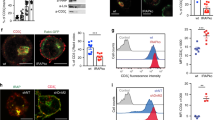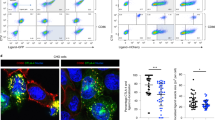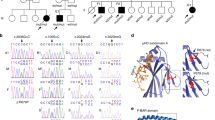Abstract
For members of the CD1 family of β2-microglobulin–associated lipid-presenting molecules, tyrosine-based motifs in the cytoplasmic tail and invariant chain (Ii) govern glycoprotein trafficking through endosomal compartments. Little is known about the intracellular pathways of CD1 trafficking and antigen presentation. However, in vitro studies with cells transfected with mutant CD1 that had a truncated cytoplasmic tail have suggested a role for these tyrosine motifs in some, but not all, antigenic systems. By introducing a deletion of the tyrosine motif into the germ line, and through homologous recombination in embryonic stem cells, we now describe knock-in mice with the CD1d cytoplasmic tail deleted. Despite adequate surface CD1d expression and the presence of Ii, these mutant mice showed multiple and selective abnormalities in intracellular trafficking, antigen presentation and T cell development, demonstrating the critical functions of the CD1d cytoplasmic tail motif in vivo.
This is a preview of subscription content, access via your institution
Access options
Subscribe to this journal
Receive 12 print issues and online access
$209.00 per year
only $17.42 per issue
Buy this article
- Purchase on Springer Link
- Instant access to full article PDF
Prices may be subject to local taxes which are calculated during checkout






Similar content being viewed by others
References
Kasahara, M., Nakaya, J., Satta, Y. & Takahata, N. Chromosomal duplication and the emergence of the adaptive immune system. Trends Genet. 13, 90–92 (1997).
Calabi, F., Jarvis, J. M., Martin, L. H. & Milstein, C. Two classes of CD1 genes. Eur. J. Immunol. 19, 285–292 (1989).
Porcelli, S. A. & Modlin, R. L. The CD1 system: antigen-presenting molecules for T cell recognition of lipids and glycolipids. Annu. Rev. Immunol. 17, 297–329 (1999).
Park, S. H. & Bendelac, A. CD1-restricted T-cell responses and microbial infection. Nature 406, 788–792 (2000).
Sugita, M. et al. Cytoplasmic tail-dependent localization of CD1b antigen-presenting molecules to MIICs. Science 273, 349–352 (1996).
Jackman, R. M. et al. The tyrosine-containing cytoplasmic tail of CD1b is essential for its efficient presentation of bacterial lipid antigens. Immunity 8, 341–351 (1998).
Brossay, L. et al. Mouse CD1-autoreactive T cells have diverse patterns of reactivity to CD1+ targets. J. Immunol. 160, 3681–3688 (1998).
Sugita, M. et al. Separate pathways for antigen presentation by CD1 molecules. Immunity 11, 743–752 (1999).
Chiu, Y. H. et al. Distinct subsets of CD1d-restricted T cells recognize self-antigens loaded in different cellular compartments. J. Exp. Med. 189, 103–110 (1999).
Briken, V., Jackman, R. M., Watts, G. F., Rogers, R. A. & Porcelli, S. A. Human CD1b and CD1c isoforms survey different intracellular compartments for the presentation of microbial lipid antigens. J. Exp. Med. 192, 281–288 (2000).
Schaible, U. E., Hagens, K., Fischer, K., Collins, H. L. & Kaufmann, S. H. Intersection of group I CD1 molecules and mycobacteria in different intracellular compartments of dendritic cells. J. Immunol. 164, 4843–4852 (2000).
Porcelli, S., Morita, C. T. & Brenner, M. B. CD1b restricts the response of human CD4-8- T lymphocytes to a microbial antigen. Nature 360, 593–597 (1992).
Sieling, P. A. et al. CD1-restricted T cell recognition of microbial lipoglycan antigens. Science 269, 227–230 (1995).
Shamshiev, A. et al. The αβ T cell response to self-glycolipids shows a novel mechanism of CD1b loading and a requirement for complex oligosaccharides. Immunity 13, 255–264 (2000).
Prigozy, T. I. et al. Glycolipid antigen processing for presentation by CD1d molecules. Science 291, 664–667 (2001).
Kawano, T. et al. CD1d-restricted and TCR-mediated activation of Vα14 NKT cells by glycosylceramides. Science 278, 1626–1629 (1997).
Spada, F. M., Koezuka, Y. & Porcelli, S. A. CD1d-restricted recognition of synthetic glycolipid antigens by human natural killer T cells. J. Exp. Med. 188, 1529–1534 (1998).
Burdin, N. et al. Selective ability of mouse CD1 to present glycolipids: α-galactosylceramide specifically stimulates Vα14+ NK T lymphocytes. J. Immunol. 161, 3271–3281 (1998).
Jayawardena-Wolf, J., Benlagha, K., Chiu, Y.-H., Mehr, R. & Bendelac, A. CD1d endosomal trafficking is independently regulated by an intrinsic CD1d-encoded tyrosine motif and by the invariant chain. Immunity 15, (in the press, 2001).
Park, S.-H., Roark, J. H. & Bendelac, A. Tissue specific recognition of mouse CD1 molecules. J. Immunol. 160, 3128–3134 (1998).
Chen, Y. H. et al. Expression of CD1d2 on thymocytes is not sufficient for the development of NK T cells in CD1d1-deficient mice. J. Immunol. 162, 4560–4566 (1999).
Park, S. H. et al. Selection and expansion of CD8α/α(1) T cell receptor α/β(1) intestinal intraepithelial lymphocytes in the absence of both classical major histocompatibility complex class I and nonclassical cd1 Molecules. J. Exp. Med. 190, 885–890 (1999).
Benlagha, K., Weiss, A., Beavis, A., Teyton, L. & Bendelac, A. In vivo identification of glycolipid antigen specific T cells using fluorescent CD1d tetramers. J. Exp. Med 191, 1895–1903 (2000).
Park, S. H. et al. The mouse CD1d-restricted repertoire is dominated by a few autoreactive T cell receptor families. J. Exp. Med. 193, 893–904 (2001).
Bendelac, A., Rivera, M. N., Park, S.-H. & Roark, J. H. Mouse CD1-specific NK1 T cells. Development, specificity, and function. Ann. Rev. Immunol. 15, 535–562 (1997).
Bix, M., Coles, M. & Raulet, D. Positive selection of Vβ8+ CD4−8− thymocytes by class I molecules expressed by hematopoietic cells. J. Exp. Med. 178, 901–908 (1993).
Bendelac, A., Killeen, N., Littman, D. & Schwartz, R. H. A subset of CD4+ thymocytes selected by MHC class I molecules. Science 263, 1774–1778 (1994).
Ohteki, T. & MacDonald, H. R. Major histocompatibility complex class I related molecules control the development of CD4+8− and CD4−8− subsets of natural killer 1.1+ T cell receptor-α/β+ cells in the liver of mice. J. Exp. Med. 180, 699–704 (1994).
Bendelac, A. Positive selection of mouse NK1+ T cells by CD1-expressing cortical thymocytes. J. Exp. Med. 182, 2091–2096 (1995).
Coles, M. C. & Raulet, D. H. NK1.1+ T cells in the liver arise in the thymus and are selected by interactions with class I molecules on CD4+CD8+ cells. J. Immunol. 164, 2412–2418 (2000).
Lantz, O. & Bendelac, A. An invariant T cell receptor α chain is used by a unique subset of MHC class I-specific CD4+ and CD4−8− T cells in mice and humans. J. Exp. Med. 180, 1097–1106 (1994).
Bendelac, A. et al. CD1 recognition by mouse NK1+ T lymphocytes. Science 268, 863–865 (1995).
Roark, J. H. et al. CD1.1 expression by mouse antigen presenting cells and marginal zone B cells. J. Immunol. 160, 3121–3127 (1998).
Acknowledgements
We thank B. Jabri, G. Waters and M. Weigert for advice and discussions and J. Goodhouse for help with confocal microscopy. Supported by grants from the Korea Research Foundation (grant 2001-015-DS0063 to S.-H. P.), ACS and NIH (to A. B.) as well as the Cancer Research Institute (Y.-H. C.), the Leukemia and Lymphoma Society of America (K. B.) and the Human Frontier Science Program (C. F.).
Author information
Authors and Affiliations
Corresponding authors
Rights and permissions
About this article
Cite this article
Chiu, YH., Park, SH., Benlagha, K. et al. Multiple defects in antigen presentation and T cell development by mice expressing cytoplasmic tail–truncated CD1d. Nat Immunol 3, 55–60 (2002). https://doi.org/10.1038/ni740
Received:
Accepted:
Published:
Issue Date:
DOI: https://doi.org/10.1038/ni740
This article is cited by
-
Developmentally programmed early-age skin localization of iNKT cells supports local tissue development and homeostasis
Nature Immunology (2023)
-
CD1-mediated immune responses in mucosal tissues: molecular mechanisms underlying lipid antigen presentation system
Experimental & Molecular Medicine (2023)
-
CD1d-dependent rewiring of lipid metabolism in macrophages regulates innate immune responses
Nature Communications (2022)
-
Thymic development of unconventional T cells: how NKT cells, MAIT cells and γδ T cells emerge
Nature Reviews Immunology (2020)
-
Control of CD1d-restricted antigen presentation and inflammation by sphingomyelin
Nature Immunology (2019)



